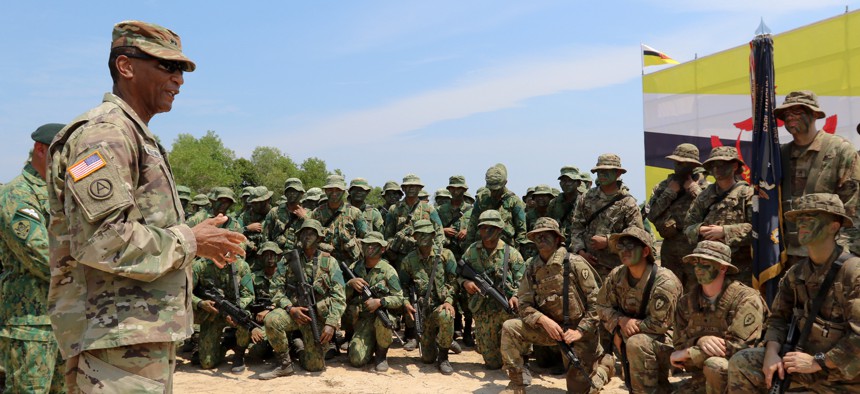
Maj. Gen. Timothy McKeithen, the deputy commanding general-National Guard, USARPAC, provides closing remarks to Exercise Pahlawan Warrior participants at Penanjong Garrison, Brunei, 14 Aug. 2018. Sgt. 1st Class Corey Ray
In the Pacific, US Army Must Be a Running Back Who Blocks
Joint success in the world’s largest theater requires the service to accept supporting roles, an Army War College study finds.
A professional football team that intends to win must have players who excel at roles outside their obvious specialization — running backs, for example, who can block defenders and receive passes. Our era of emerging great power competition — or, as we suggest, more appropriately hypercompetition —demands a Joint Force whose individual military components are ready and willing to perform missions outside their preferred service narratives. Nowhere is this truer than in the Indo-Pacific region.
Hypercompetition is a relentless struggle for transient advantage where physical, virtual, and cognitive maneuver create temporary windows of opportunity. In the area of responsibility of U.S. Indo-Pacific Command, or INDOPACOM, hypercompetition is demanding transformation of all services, but perhaps most profoundly for the U.S. Army.
Since October, U.S. Army War College researchers have looked into Indo-Pacific theater design at and beyond 2028 on behalf of the Secretary of the Army. Though we have found that U.S. and partner forces have an impressive body of work under way, it is clear that the Army must change across five major elements of design: strategy and operational concepts; forces and capabilities; footprint and presence; authorities, permissions, and agreements; and mission command arrangements. A full report on our findings will be out this summer, but some team members are presenting preliminary findings this week at the Land Forces Pacific Symposium (LANPAC) in Hawaii.
A central conclusion in our work: theater success will require better joint cooperation. We found that the Army and its sister services are generally rowing in the same direction – working to thwart a rival great power – but are not necessarily in the same boat. Each has path-breaking ideas that require help from other services, yet have not completed the joint spadework necessary to realize them. What are needed are concepts, strategies, and plans that are joint from inception through execution, and military components that accept and excel at counter-cultural service roles and missions.
To wit: in INDOPACOM, the Army must not optimize for its preferred role of large-scale ground combat reliant on large maneuver forces. Instead, it will be an enabler of joint forces, a builder of partner capability and capacity, and a warfighter. Though the Army will help deter China as part of a joint and combined force, and certainly would fight in multiple domains as a member of that force, our research shows that in INDOPACOM the Army should embrace its essential theater role as the principal joint enabler. The Army is the enabling backbone that allows U.S. and partner forces to expand the competitive space, create dilemmas for and impose costs on their rivals, and generate more expansive joint military options. It does this through permanent and rotational presence, prepositioning materiel, and persistent exercises and operations.
Related: In Pacific, US Army Shifts Training from Disaster Relief to War
Related: Army Secretary Reveals Weapons Wishlist for War with China & Russia
Related: China’s Military Is Getting Better at a Lot of Things at Once: Pentagon Intelligence
But more is needed to support joint missions across a vast, complicated, and hypercompetitive region. The Army must increase its depth, by nurturing longstanding relationships with treaty allies and traditional partners and cultivating new partnerships based on common need and interest. The service must increase its theater redundancy, meaning the number of choices for conducting and sustaining military operations. And it needs increased resilience: the ability to operate despite adversity, an ability that combines depth, redundancy, distribution, and protection.
A deeper, more redundant, more resilient, and more joint-focused INDOPACOM Army will require transformation in mission command, sustainment, protection, intelligence, and force configuration. Its Indo-Pacific future requires smaller, multi-functional, mission-tailored units of action that are inherently joint in their orientation and operate with greater autonomy at lower levels of aggregation. This is not the current trend in Army modernization.
Our work suggests the earliest and most significant changes for the Army in INDOPACOM will stem from innovation in operational concepts, task organization, mission-tailoring, and physical posture. These changes must be follow a coherent theater-level joint concept for competition and armed conflict.
The Army may be hesitant to adopt the culture-bending roles demanded by INDOPACOM’s unique form of hypercompetitive military rivalry. Further, the Joint Force may not yet fully appreciate the importance of the Army’s contributions to theater success in both competition and armed conflict. Thus a meeting of the minds is needed both within the Army and across the Joint Force.
Among senior Army leaders, a new corporate appreciation of INDOPACOM’s unique theater demands will inevitably lead to a transformational vision for theater Army forces and concepts. For their part, Joint Force leaders will benefit from an Army that is fully integrated into theater design as the enabling foundation for broader INDOPACOM success. We are certain LANPAC provides an excellent venue to start this important conversation with joint, combined, and Army leaders at all levels.
John Schaus, Nathan Freier, Michael Cable, and Dana Tucker are members of a U.S. Army War College team focused on INDOPACOM theater design in 2028 and beyond. Schaus and Freier are the project’s co-directors. The views expressed in this article are the authors’ and do not necessarily reflect the official policy or position of the United States Army War College, the United States Army, the Department of Defense, or the United States government.



